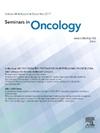绘制癌症相关性贫血的流行病学:全球患病率和发病率的系统范围审查。
IF 2.5
3区 医学
Q2 ONCOLOGY
引用次数: 0
摘要
肿瘤相关性贫血(CRA)是肿瘤患者中一种常见的衰弱性疾病,由肿瘤负担、治疗毒性、营养缺乏和全身性炎症驱动。这篇综述的目的是综合证据的全球和地理流行和发病率模式的CRA。对PubMed和Embase进行了系统搜索,确定了2000年至2024年11月30日期间发表的关于CRA的英语研究。报告CRA患病率和/或发病率的观察性研究和临床试验被纳入。提取的数据涵盖国家、研究设计、患者人口统计、癌症类型、贫血分类和CRA发病率/患病率。然后将数据按地理位置绘制成图表。共纳入了42项研究,涉及5大洲40个国家的65179名癌症患者。CRA患病率从12.8%到100%不等,其中肺癌(84.2%)、儿科癌症(80.9%)、妇科癌症(62.99%)和胃肠道癌症(57.4%)的发病率最高。多种癌症类型和实体肿瘤的贫血综合患病率分别为64.99%和25.68%。然而,癌症类型特异性分析通常报告的患病率高于综合结果,其差异在很大程度上受地理位置的影响。化疗和放疗始终与发病率增加相关,在一些队列中,治疗后贫血患病率达到100%。注意到区域差异,特别是在非洲、南美洲、中东和北非区域。CRA是一种全球流行的疾病,其发病率受癌症类型、地理区域和化疗或放疗开始的影响。未来的研究应优先考虑标准化报告和解决区域数据差距。本文章由计算机程序翻译,如有差异,请以英文原文为准。
Mapping the epidemiology of cancer-related anemia: A systematic scoping review of global prevalence and incidence
Cancer-related anemia (CRA) is a common and debilitating condition among oncology patients, driven by tumor burden, treatment toxicity, nutritional deficiencies, and systemic inflammation. This review aims to synthesize evidence on the global and geographical prevalence and incidence patterns of CRA. A systematic search of PubMed and Embase identified English-language studies on CRA published was performed between 2000 and November 30, 2024. Observational studies and clinical trials reporting CRA prevalence and/or incidence were included. Extracted data covered country, study design, patient demographics, cancer type, anemia classification, and CRA incidence/prevalence rates. The data were then charted by geographical locations. A total of 42 studies, encompassing 65,179 cancer patients across 5 continents and 40 countries, were included. CRA prevalence ranged from 12.8% to 100%, with the highest rates reported in lung (84.2%), pediatric cancers (80.9%), gynecological (62.99%), and gastrointestinal (57.4%) cancers. The composite prevalence of anemia across multiple cancer types and solid tumors was 64.99% and 25.68%, respectively. However, cancer-type-specific analyses often reported higher prevalence rates than composite outcomes, with variations largely influenced by geographical location. Chemotherapy and radiotherapy were consistently associated with increased incidence, with post-treatment anemia prevalence reaching 100% in some cohorts. Regional disparities were noted, particularly in Africa, South America, and the Middle East and North Africa (MENA) region. CRA is a globally prevalent condition, with rates influenced by cancer type, geographic region, and the initiation of chemotherapy or radiotherapy. Future research should prioritize standardized reporting and address regional data gaps.
求助全文
通过发布文献求助,成功后即可免费获取论文全文。
去求助
来源期刊

Seminars in oncology
医学-肿瘤学
CiteScore
6.60
自引率
0.00%
发文量
58
审稿时长
104 days
期刊介绍:
Seminars in Oncology brings you current, authoritative, and practical reviews of developments in the etiology, diagnosis and management of cancer. Each issue examines topics of clinical importance, with an emphasis on providing both the basic knowledge needed to better understand a topic as well as evidence-based opinions from leaders in the field. Seminars in Oncology also seeks to be a venue for sharing a diversity of opinions including those that might be considered "outside the box". We welcome a healthy and respectful exchange of opinions and urge you to approach us with your insights as well as suggestions of topics that you deem worthy of coverage. By helping the reader understand the basic biology and the therapy of cancer as they learn the nuances from experts, all in a journal that encourages the exchange of ideas we aim to help move the treatment of cancer forward.
 求助内容:
求助内容: 应助结果提醒方式:
应助结果提醒方式:


